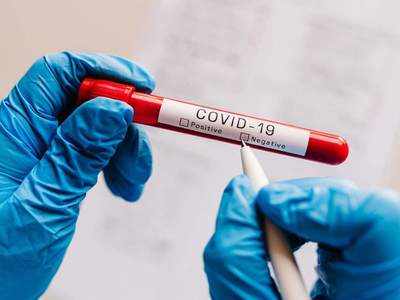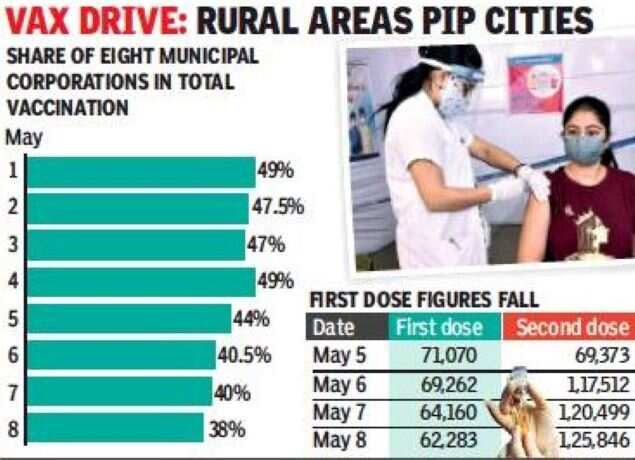- News
- City News
- ahmedabad News
- Gujarat’s daily Covid testing dips 17%, cases fall 10% in a week
Gujarat’s daily Covid testing dips 17%, cases fall 10% in a week

On the other hand, the average test positivity rate (TPR) has increased in a week – compared to 9.2% in the first week of May, the last week of April had recorded a TPR of 8.5%
AHMEDABAD: From May 1 to 7, Gujarat recorded an average daily 12,894 Covid-19 positive cases, which fell to 11,892 on Saturday which was the lowest daily tally after 18 days.
While the data for daily testing on Saturday was not available, analysis of the past two weeks – from May 1 to 7 and April 24 to 30 – reveal that the daily testing for Covid went down by 17% in a week. Since May 1, the daily tests have not exceeded 1.5 lakh, which according to experts, is one of the reasons for the fall in daily cases – 10% in seven days.

“While dependence on Rapid Antigen Test (RAT) is reduced even in the rural areas, there is no restriction on RT-PCR tests. But people would go for the Covid testing if they get the symptoms. Thus, one can safely say that the overall cases are on the downward slope in Gujarat,” said a senior health department official, citing less queues outside testing centres and major hospitals.
To put the figure in perspective, bed occupancy in private hospitals in Ahmedabad was 82%, down from 93% on April 30.
On the other hand, the average test positivity rate (TPR) has increased in a week – compared to 9.2% in the first week of May, the last week of April had recorded a TPR of 8.5%. The urban-rural divide is also recorded with four major districts (Ahmedabad, Surat, Vadodara and Rajkot) recording 8% TPR on Friday compared to the state's 8.7%. The rest of Gujarat had a TPR of 9.5%.
Analysis of the vaccination in Gujarat records a downward trend for the first and upward trend for the second doses – on Saturday, against 62,283 first shots, 1.25 lakh got the second shot. State health department officials said that the division of vaccination centres for the 18-45 years and 45+ years is one of the reasons. They added that once the new stock of vaccines arrives, the number of first jabs would improve.
The share of eight municipal corporations in the total vaccination fell to 38% on Saturday from 49% or nearly half the share on May 1. The experts interpret it as a rise in vaccination in rural areas and other districts, as the cases have also recorded a rise. “Earlier vaccination had higher share in cities, but people have realized that vaccination is one of the ways to keep the virus at bay. We can see the correlation,” said a public health expert.
While the data for daily testing on Saturday was not available, analysis of the past two weeks – from May 1 to 7 and April 24 to 30 – reveal that the daily testing for Covid went down by 17% in a week. Since May 1, the daily tests have not exceeded 1.5 lakh, which according to experts, is one of the reasons for the fall in daily cases – 10% in seven days.

“While dependence on Rapid Antigen Test (RAT) is reduced even in the rural areas, there is no restriction on RT-PCR tests. But people would go for the Covid testing if they get the symptoms. Thus, one can safely say that the overall cases are on the downward slope in Gujarat,” said a senior health department official, citing less queues outside testing centres and major hospitals.
To put the figure in perspective, bed occupancy in private hospitals in Ahmedabad was 82%, down from 93% on April 30.
On the other hand, the average test positivity rate (TPR) has increased in a week – compared to 9.2% in the first week of May, the last week of April had recorded a TPR of 8.5%. The urban-rural divide is also recorded with four major districts (Ahmedabad, Surat, Vadodara and Rajkot) recording 8% TPR on Friday compared to the state's 8.7%. The rest of Gujarat had a TPR of 9.5%.
Analysis of the vaccination in Gujarat records a downward trend for the first and upward trend for the second doses – on Saturday, against 62,283 first shots, 1.25 lakh got the second shot. State health department officials said that the division of vaccination centres for the 18-45 years and 45+ years is one of the reasons. They added that once the new stock of vaccines arrives, the number of first jabs would improve.
The share of eight municipal corporations in the total vaccination fell to 38% on Saturday from 49% or nearly half the share on May 1. The experts interpret it as a rise in vaccination in rural areas and other districts, as the cases have also recorded a rise. “Earlier vaccination had higher share in cities, but people have realized that vaccination is one of the ways to keep the virus at bay. We can see the correlation,” said a public health expert.
FacebookTwitterLinkedinEMail
Start a Conversation
end of article
Trending Topics
Top Stories Right Now
- indiaPositivity rate 20% or more in 2 out of every 5 districts in India
- indiaEarly signs of 2nd wave peaking as growth slows
- indiaAssam: Himanta may be CM, BJP may recall Sonowal to Delhi
- indiaSC ropes in experts for national task force to overhaul allocation of O2 to stat...
- indiaFix vaccination drive, ensure poor & villagers not left out: Lancet
Quick Links
Delhi Air PollutionDelhi TemperatureChennai WeatherBangalore TemperatureCovid vaccination centres in DelhiCoronavirus in DelhiRTPCR test in GurgaonHyderabad RainPollution level in BangaloreDelhi SmogDelhi TemperatureNoida AQIGurgaon AQI todayFire in MumbaiMumbai RainsCovid 19 RT PCR Test in NoidaDelhi AQI todaySrinagar encounter